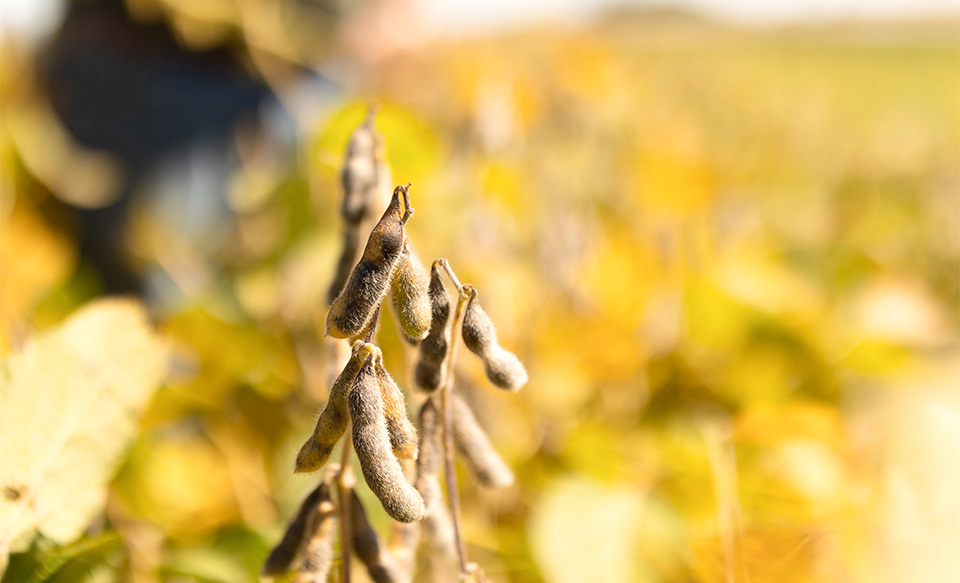
(Photo: Iowa Soybean Association / Joclyn Bushman)
Soybean yields lower in latest WASDE report
September 14, 2023
The U.S. Department of Agriculture (USDA) this week has lowered its estimates for soybean yields.
The USDA’s September World Agricultural Supply and Demand Estimates (WASDE) dropped its average yield estimate to 50.1 bushels per acre, a 0.8-bushel drop from August, which included a 1.1-bushel decrease from July. The USDA did raise its harvested area estimate for soy, but also cut its production forecast.
USDA is now predicting U.S. soybean production this year will total 4.146 billion bushels, down 59 million from the August forecast of 4.205 billion bushels.
Meanwhile, the soybean crush forecast is reduced 10 million bushels and the export forecast is reduced 35 million bushels on lower supplies, according to the USDA. Ending stocks are projected at 220 million bushels, down 25 million from last month.
The U.S. season-average soybean price is forecast at $12.90 per bushel, up 20 cents from last month. The soybean meal price is unchanged at $380 per short ton and the soybean oil price is raised 1 cent to 63 cents per pound.
The WASDE report also noted that global 2023/24 soybean crush is reduced 1.8 million tons to 327.7 million on lower crush for Argentina, Pakistan, the European Union (EU), Thailand and the United States. Argentina’s crush is reduced 1.8 million tons to 34.5 million on lower expected supplies over the next several months prior to next year’s harvest. China’s crush is raised 1 million tons to 96 million in line with higher crush and domestic soybean meal demand in the prior marketing year.
Global soybean exports are reduced 0.4 million tons to 168.4 million as lower U.S. exports are partly offset by higher shipments from Brazil and Ukraine. Imports are reduced for Pakistan, Thailand, the EU and Indonesia. Conversely, China’s imports for 2022/23 and 2023/24 are increased on higher crush demand and large shipments from Brazil that are expected to continue into the next marketing year. Global soybean ending stocks are reduced 0.2 million tons to 119.2 million.
Weather update
The estimated lowered yields, is due in part to a hot and dry August for much of the soybean-producing states, including Iowa.
That being said, a week of above average temperatures and below average precipitation resulted in 6.5 days suitable for fieldwork for Iowa farmers this past week according to the USDA’s National Agricultural Statistics Service (NASS). Field activities included chopping corn silage as well as cutting and baling hay. A few reports of corn and soybean harvest were received.
NASS indicated that in Iowa topsoil moisture condition rated 37% very short, 42% short, 21% adequate and 0% surplus. Subsoil moisture conditions rated 35% very short, 43% short, 21% adequate and 1% surplus.
The report also says soybean coloring or beyond reached 67%, six days ahead of last year and five days ahead of the average. Soybeans dropping leaves was at 25% this week, one week ahead of last year and three days ahead of normal. Soybean conditions fell five percentage points to 44% good to excellent.
The latest U.S. Drought Monitor indicates that much of the state of Iowa is reporting moderate to severe drought conditions, with a good portion of northeast Iowa and a part of southeast Iowa in an extreme drought mode.
According to State Climatologist Justin Glisan, the intense heat that had impacted the state earlier last week gave way to cooler temperatures toward the end. Along with some chilly overnight lows, the statewide average temperature was at 69.3 degrees. Rainfall again was sparse with widespread deficits of more than 0.5 inch across much of Iowa, though the northeast registered near-normal totals.
The 10-day forecast calls for temperatures to remain mild (mid-70s to mid-80s) with moderate chances of rainfall in the state.
Positive outlook
Iowa Soybean Association farmer-member Ray Gaesser says despite the project numbers from the latest WASDE report and issues related to weather, he’s optimistic about his soybean crop this year.
Gaesser, who farms in Adams County in southwest Iowa says his part of the state was blessed with some decent rainfall and the recent heat did not have too much of an impact on his crops.
“We really had some good rains,” he says. “I think we’re going to be slightly above average in our yields.”
Gaesser acknowledges that while a small portion of his soybeans were impacted by white mold, most of the fields were healthy.
He anticipates harvesting his soybean crop within about a week to 10 days.
Back